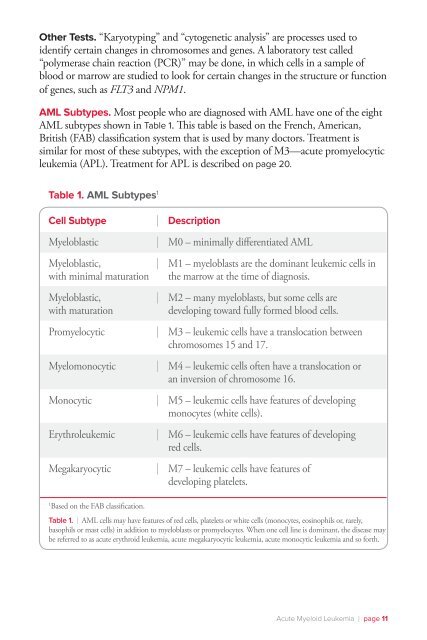Acute Myeloid Leukemia - The Leukemia & Lymphoma Society
Acute Myeloid Leukemia - The Leukemia & Lymphoma Society
Acute Myeloid Leukemia - The Leukemia & Lymphoma Society
- No tags were found...
You also want an ePaper? Increase the reach of your titles
YUMPU automatically turns print PDFs into web optimized ePapers that Google loves.
Other Tests. “Karyotyping” and “cytogenetic analysis” are processes used toidentify certain changes in chromosomes and genes. A laboratory test called“polymerase chain reaction (PCR)” may be done, in which cells in a sample ofblood or marrow are studied to look for certain changes in the structure or functionof genes, such as FLT3 and NPM1.AML Subtypes. Most people who are diagnosed with AML have one of the eightAML subtypes shown in Table 1. This table is based on the French, American,British (FAB) classification system that is used by many doctors. Treatment issimilar for most of these subtypes, with the exception of M3—acute promyelocyticleukemia (APL). Treatment for APL is described on page 20.Table 1. AML Subtypes 1Cell SubtypeMyeloblasticMyeloblastic,with minimal maturationMyeloblastic,with maturationPromyelocyticMyelomonocyticMonocyticErythroleukemicMegakaryocyticI DescriptionI M0 – minimally differentiated AMLI M1 – myeloblasts are the dominant leukemic cells inthe marrow at the time of diagnosis.I M2 – many myeloblasts, but some cells aredeveloping toward fully formed blood cells.I M3 – leukemic cells have a translocation betweenchromosomes 15 and 17.I M4 – leukemic cells often have a translocation oran inversion of chromosome 16.I M5 – leukemic cells have features of developingmonocytes (white cells).I M6 – leukemic cells have features of developingred cells.I M7 – leukemic cells have features ofdeveloping platelets.1Based on the FAB classification.Table 1. I AML cells may have features of red cells, platelets or white cells (monocytes, eosinophils or, rarely,basophils or mast cells) in addition to myeloblasts or promyelocytes. When one cell line is dominant, the disease maybe referred to as acute erythroid leukemia, acute megakaryocytic leukemia, acute monocytic leukemia and so forth.<strong>Acute</strong> <strong>Myeloid</strong> <strong>Leukemia</strong> I page 11
















